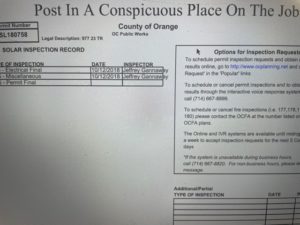Many California home solar projects are delayed because homeowners tend to procrastinate going solar. They know it will save them money, and it is the right thing to do for the planet, but they don’t realize how easy it is! When done properly the time investment for the homeowner is roughly an hour upfront. Your solar installer will manage the rest of the process, which I describe here. Please note, the entire process of a California home solar project can be done virtually!
The entire process for a California homeowner to go solar can take from 8-12 weeks depending on a variety of factors including the city you live in and the utility that provides the electricity to your home. There are seven steps in the process (System Sizing, Contracting, Site Audit, Permitting, Installation, Final Inspection, and Permission To Operate) and I will break them down into further detail here.
System Sizing: This is the first step of the process. A general rule to keep in mind is if your electric bill is under $100 per month the project will not pencil out financially. Of course, if you still want to go solar to do the right thing for the planet you can do so but the return on investment takes longer. I would advise signing up for a 100% renewable energy option through your electric utility if this is your situation. As the homeowner you will need to engage a solar company or solar consultant to size a solar system for your home based off the previous 12 months of consumption data and any future improvements to the home that may add to the energy consumption (such as a pool, air conditioning, or the purchase of an electric vehicle). All solar companies offer this service for free; and all that is needed is a recent electric bill, a picture of your electrical panel, and a picture of your roof. The solar company will provide a written proposal showing the layout of the solar system on the home’s roof, the energy production the homeowner can expect to receive from the solar system, and an estimate of your utility bill savings. Keep in mind that the preliminary solar design for your home solar project can change based on the results of the site audit!
Contracting: After consulting with a solar company the homeowner will select a form of payment for their solar system (lease, cash, or financed) and sign a contract for the installation of the solar system on their property as well as any relevant loan documents necessary (if financing the solar system).
Site Audit: Once a signed contract is in place your solar company will send a representative out to your home to measure and mark the roof for the placement of the solar panels, inspect your main electrical panel, and perform a shading analysis to ensure your solar panels have direct sunlight and confirm how much energy the solar system will generate. The site audit typically takes about an hour, and the homeowner does not need to be home. Many solar companies are now doing these site audits virtually. The results of the site audit will be shared with the homeowner.
Permitting: After the homeowner approves the layout of the solar panels your solar company will have a licensed engineer design plans for the solar system to be installed at your home. They will then submit the plans to the city’s building department in person or electronically if the city allows. The city or ‘Authorized Housing Jurisdiction’ (AHJ) will then review the plans to make sure they conform to all local codes prior to issuing a building permit for the solar system. This process can take between 4-8 weeks depending upon the AHJ.
Installation: The actual physical construction of the solar system by your solar installation company or “installer”. This can usually be finished in two days; but may take longer if there is other work required for the solar system to be installed (for example: upgrading a main electrical panel or re-roofing with composition shingle under the solar panels on a Spanish clay tile roof).
Final Inspection: An inspector from your AHJ will come to your home to ensure that the solar system was installed according to code and is working properly. Your installer will have a representative meet the inspector on inspection day at your home.
Permission To Operate (PTO): After passing final inspection with the AHJ, PTO is the final step in the process. Your installer will provide all relevant utility paperwork including your Net Energy Metering Agreement to the utility. Your utility will process the paperwork and issue PTO, or permission to operate your solar system. Upon receiving notification of PTO from your utility, you are officially “interconnected” to the electric grid and your Net Energy Metering agreement takes effect. You will start to receive bill credits for any excess energy production sent to the grid from your solar system. California homeowners beware! The utilities in California are so backed up processing solar interconnections that their system is taking months to change homeowners over to annual solar billing. Many of our clients have received a bill from their utility after going solar and upon reaching out to the electric utility have been advised of this backlog. Rest assured the electric utility will credit your account for any errors in billing after going solar!
Want to see how much money you can save with a home solar panel and solar battery system? Get your turnkey California home solar panel and solar battery proposal with ROI and financing options by e-mailing us your most recent electric bill (all pages), a picture of the electrical panel outside your home, and a picture of your roof today: info@beachcitiessolarconsulting.com


